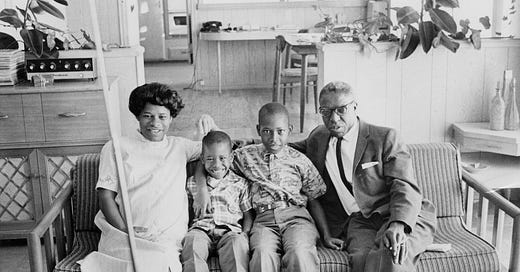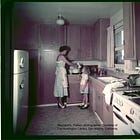
“Someone dumped garbage on our lawn that first night. I found it when I left for work in the morning. I stayed home with my family that day.”
-Wade Rice, one of the first Blacks in a white neighborhood in the Valley, circa 1965.
Moving to the predominantly white suburbs of the San Fernando Valley was fraught for Black families in the 1960s. Scary white people were not game to share their well-funded public schools and panicked over their property values; the Ku Klux Klan started becoming more visible. But Black families moved here anyway. Their experiences and lives weren’t exactly a “Welcome to Los Angeles!” postcard.
One of the first reported Black families to move to the Valley during this time was the Rice family. In 1961, Wade Rice bought a home in Northridge and moved in with his wife, Fannie, and their four children. They arrived from Central Los Angeles in what Wade described as “the Negro ghetto.” In a short film, which includes a credit to the Fair Housing Council of the San Fernando Valley (FHC/SFV), Wade and his family perform a reenactment of their move to the San Fernando Valley. In the voice-over narration, Wade describes the first few years of their life in white suburbia.
On the stress of the move on his wife and the reaction of his Black friends:
“For Fannie, it was rough. She was born in the South and she didn’t feel right about this. It took guts for her to come out here. My buddies from the ghetto thought I was crazy to move out here. ‘Why sweat it?’ they said. Well, a lot of Negro families have moved into the white suburbs around LA—maybe a couple thousand families—and it’s tough on them at first. But if we don’t do it, who is?”
On how Fannie coped:
“Some of my buddies who move into the suburbs, every day when they went to work—the first few months— their wives would take the kids and visit friends in the ghetto. That’s what Fannie figured she would do.”
On living with white people:
“Living here is part of my children’s education. They get to learn that the whites’ way of life, his aspirations, aren’t any different than ours. There’s no big mystery about it. We all live in the same boat and we are all trying to make it.”
While the archival footage is incredible, the film very much comes across as a stilted ad for integration: white neighbors rush to the aid of the Rice family, smiling white families come to their home, white and Black children play together in the street. It looks staged because it is.
Wade walks across his lawn in a reenactment of his first morning waking up in his new home. He recounts leaving for work and finding trash all over his lawn. A white neighbor is depicted as helping him clean up the mess, suggesting a responsibility for white Valley residents to combat racism, too.
A white neighbor is depicted as helping him clean up the mess, suggesting a responsibility for white Valley residents to combat racism, too.
This suggestion is stressed further: Wade narrates meeting with a white friend of a friend who was an upstanding member of the local Lutheran church. Together, they organized a meeting to address the neighborhood concerns about the singular, brand-new Black family on the block. They cite the usual racist script from this time; greatest hits include declining property values, hand-wringing about their white kids marrying the Rice kids, and more and more Black families “invading” the Valley.
To Wade’s account, some families did move away. But the general tonality of the film is that, despite initial harassment, the move was ultimately beneficial to the Rice family and therefore is to other Black families.
What you don’t see depicted in the reenactment is the shotgun the Rice family moved to the Valley with—a detail included in a news report featuring Wade some years later. While Wade agrees that the move was worth it, he assesses the gains as much bigger than the immediate needs or even safety of his family:
“It’s amazing to walk around the neighborhood now and you see little Black kids and just my mind rolls back 25 or 30 years and I wonder if they realize what the old folks are going through so they could live in a neighborhood like this….Somebody had to take the risk. Somebody had to take the gamble. Somebody got to step forward. And I was willing to do it. No regrets. Glad we did it. I would do it again.”
Of course, prior to the Rice family, there were some Black families in the San Fernando Valley—just in the sanctioned Black parts of the Valley. Blacks were blocked from leasing or buying homes in most (read: white) parts of the San Fernando Valley prior to the 1960s.
What you don’t see depicted in the reenactment is the shotgun the Rice family moved to the Valley with.
A constellation of racism between developers and mortgage lenders made it so Black families simply couldn’t secure the financing to buy homes in white neighborhoods, known as “redlining.” This well-known practice ensured that white families got to buy and live in solidly white neighborhoods, like where the Rices moved.
Never one to miss a financial opportunity though, developers made separate Black neighborhoods in the Valley, like the historic Joe Luis Homes in Pacoima. The 1951 housing development1 was marketed specifically to Valley-interested Blacks2 and named for the famous Black boxer, a figure that Black Americans would recognize. The marketing strategy is pretty obviously just that: Luis had no affiliation to the Joe Luis housing tract3 and made no money off of this brazen use of his name to access his Black fanbase.
While there had been Blacks in the Valley for some time, they were still very much a segregated and minority presence. In 1950, there were a reported 2,654 African-American residents in the Valley4 (of 402,538 residents total). Most Black residents lived in Pacoima and the surrounding area.
It was this segregation that the FHC/SFV was actively encouraging residents to challenge through community meetups and workshops. It can’t be stressed enough that what developers, realtors, and lenders were practicing was illegal by 1963. But without people challenging redlining on the ground, the practice continued to flourish.
A 1966 report from FHC/SFV arrived at the same conclusion, as the board voted unanimously in favor “to strengthen”5 the Rumford Fair Housing Act. One of their key observations was that “the average Valley realtor is not being confronted by minority clients asking for equal service.” (And why would they? Intimidation was mounting.)
And so some white valley girls6 challenged this norm with not just activism, but a refusal to maintain white respectability in their own neighborhoods. I’d like to think I’m descended from one of them.
Next week: the first valley girl in my family.
History, Pacoima Historical Society, www.pacoimahistoricalsociety.org/pacoima-history. Accessed 11 June 2025.
Many Black Americans moved to the Valley during the Second Great Migration in which southern Blacks moved north to escape racial discrimination and harassment.
Planning District - Joe Louis Homes Residential Planning District, HistoricPlacesLA, hpla.lacity.org/report/b7d96a3f-319c-4d55-9fcd-f486b00664bd. Accessed 11 June 2025.
Planning District - Joe Louis Homes Residential Planning District, HistoricPlacesLA, hpla.lacity.org/report/b7d96a3f-319c-4d55-9fcd-f486b00664bd. Accessed 11 June 2025.
Fair Housing Council of the San Fernando Valley, Sherman Oaks, CA, 1966, pp. 1–4, Report to the Commission to Study the Rumford Act, California State University, Northridge, San Fernando Valley History Digital Library. https://digital-collections.csun.edu/digital/collection/SFVH/id/749/rec/1. Accessed 11 June 2025.
Lowercase “valley girl” to indicate a female-identified or pangender individual who happens to be from or inhabits the San Fernando Valley.







